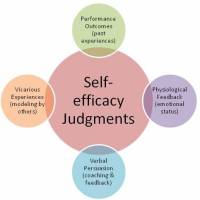 The 15 Minute Forum last week was led by science teacher, Becky Owen. Becky started the session by explaining why she thought the idea of a growth mindset was so important. Put very simply, the students that she has taught who have been and are successful, tend to have many of the attributes described by a ‘growth mindset’ (see above). They seem to understand that ‘Working harder, makes you smarter’ (thanks John Tomsett). With this in mind, Becky has been trying to adjust her teaching in order to foster this mindset with her students. The most important idea behind the growth mindset, is that intelligence is not fixed and can be developed. If students are to believe this, we need to provide opportunities for them to experience it i.e. that through their efforts, they can experience success. Alongside this of course, students also need to understand that failure, or not getting it quite right, is an important part of learning. Hopefully then, this success will breed more success. Becky went on to describe how she has been doing this.
The 15 Minute Forum last week was led by science teacher, Becky Owen. Becky started the session by explaining why she thought the idea of a growth mindset was so important. Put very simply, the students that she has taught who have been and are successful, tend to have many of the attributes described by a ‘growth mindset’ (see above). They seem to understand that ‘Working harder, makes you smarter’ (thanks John Tomsett). With this in mind, Becky has been trying to adjust her teaching in order to foster this mindset with her students. The most important idea behind the growth mindset, is that intelligence is not fixed and can be developed. If students are to believe this, we need to provide opportunities for them to experience it i.e. that through their efforts, they can experience success. Alongside this of course, students also need to understand that failure, or not getting it quite right, is an important part of learning. Hopefully then, this success will breed more success. Becky went on to describe how she has been doing this.
Developing Independence
 If students are going to have a ‘desire to learn’ they need to be motivated to do so – and believe that they can. In order to achieve this, we have to support them with the process of experiencing success – by teaching them well and moving them towards being able to work with a greater degree of independence. This is different from expecting students to learn independently – they will need input from the teacher.
If students are going to have a ‘desire to learn’ they need to be motivated to do so – and believe that they can. In order to achieve this, we have to support them with the process of experiencing success – by teaching them well and moving them towards being able to work with a greater degree of independence. This is different from expecting students to learn independently – they will need input from the teacher.
The diagram above summarises a teaching sequence that supports this. Starting with teacher explanation and modelling of the new knowledge/ skills, you can then move on to joint practice and construction e.g. writing the stages of an extended response to a question together as a class. They can start to apply what they have learnt, and give it a go themselves, using questioning and feedback to refine their thinking and work on the way.
Through scaffolding support in this way, they will eventually experience success. This will help them to believe that they can produce high quality work – and that they can then go on and get better.
Refining the teaching sequence
By thinking through her teaching as outlined above, Becky now approaches her lessons using this teaching sequence:
The starting point is what Becky wants them to learn, in terms of knowledge and skills – this is the starting point of her planning, rather than what they will do. The new knowledge will be introduced by Becky and discussed with the class – what do they already know? How can this existing knowledge be developed etc? A part of this is students watching and being focused on a range of things to support the learning e.g. a demo, a practical, a picture, a video clip, an exemplar answer etc. Students will then try to do something based on this new knowledge e.g. answer a question. Their thinking and work will then be reviewed – what have they done well? How could it be developed? They will then do the most important part – try again – based on the feedback. The idea being that we are fostering a growth mindset by encouraging students to respond to feedback and aim for excellence. The review process will then be repeated and then based on what they have done, what overall targets can they set themselves for future learning?
Question time
If students are to believe they can get better and better, they need some evidence of this. We don’t often help them with this by teaching them something, coming back to it a month or so later in an assessment and then surprisingly, they can’t do it. Becky is trying to counteract this be doing regular, low stakes tests at the start of her lessons. These take the form of 5 or so questions, based on key knowledge from previous lessons over the weeks.
By doing this, students begin to see that they are capable of retaining information and getting better and better. Their self-belief grows.
Peer Feedback
Rather than giving students a set of ‘level descriptors’ or something similar, and expecting them to assign each other a level, Becky is getting students to look at and discuss each others work.
So, for example, students might be given a question that requires an extended written answer, such as ‘Describe and explain the causes & effects of global warming’ . Once they have produced their answer, Becky then goes through the main marking points with the students:
Students then look through the work of the person they are sitting next to and look for these points. When they find each point, it is identified with a tick. They then write an improvement target for each other, based on the points they didn’t include their answer. Each student then has to redraft their work, based on this improvement target.
So, not only is this demonstrating to students the importance of ongoing improvement of their work, but it is also showing them the importance of responding to feedback.
DIRT (Directed Improvement & Reflection Time)
Much has been written about DIRT – the importance of giving students time to respond to your feedback and so improve their work. Becky has been using this to good effect, following assessments (based on exam questions, sat by students at the end of each topic). As a part of her marking, Becky identifies the weakest area for each student and assigns them an ‘improvement area’ using a T code:
If there is a target that the majority of the class need to address e.g. T5, Becky will discuss and model the answer – and then give them a related question to try. Alternatively, they may be directed to where the information that relates to the answer is e.g. in a text, book, and then be asked to either redraft their answer, or do another question on the same topic. Some students will not be able to rely on information from the text book to re-do the question – so Becky will give them personalised support to move them on.
Again, this reinforces the idea of sticking with obstacles, responding to feedback and a focus on improving their work.
And finally…
Becky has shown all of her classes the now very famous ‘Austin’s Butterfly’ clip:













Reblogged this on splozza11 and commented:
Practical application of DIRT and growth mindset! As a massive Ron Berger fan I never tire of watching Austin’s Butterfly!
For those that haven’t seen it…
Reblogged this on HPE&things.
Thank you Ruth
I have been getting these but actually hadn’t received this one! Just watched a good clip of Dweck that I hadn’t seen before too, however won’t forward to my team yet as all a bit busy with new time tables etc.
Nic